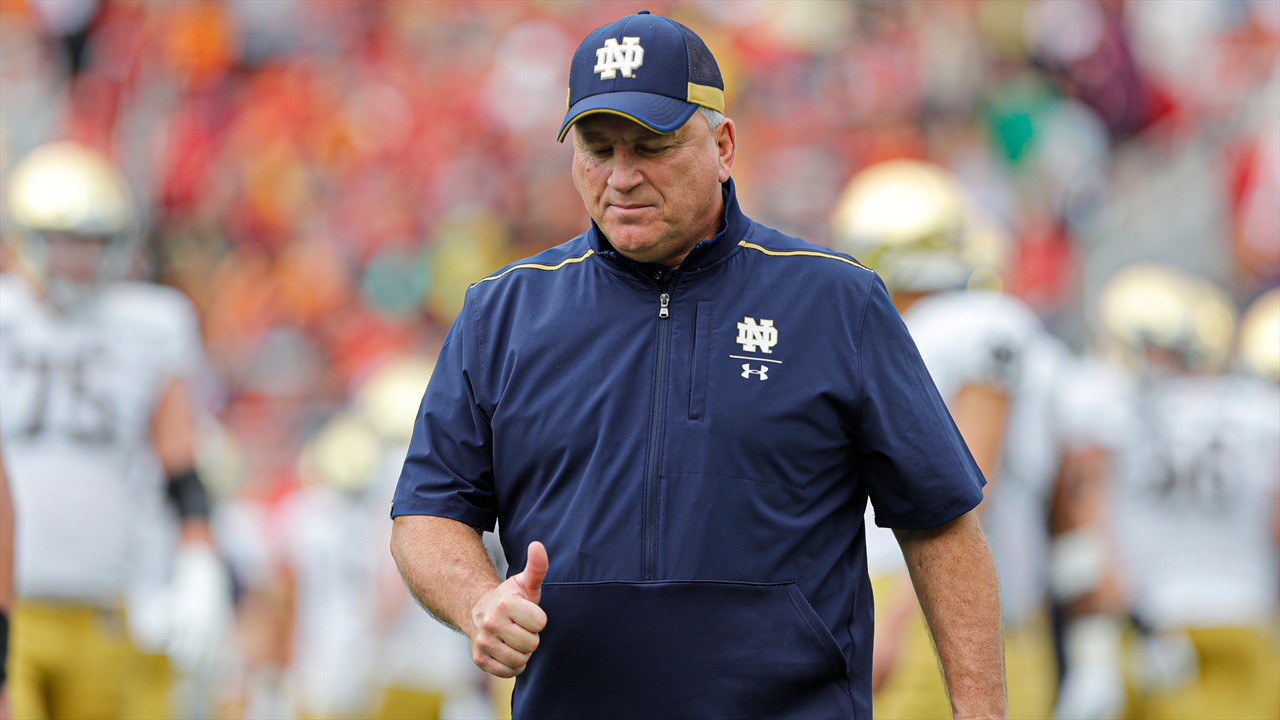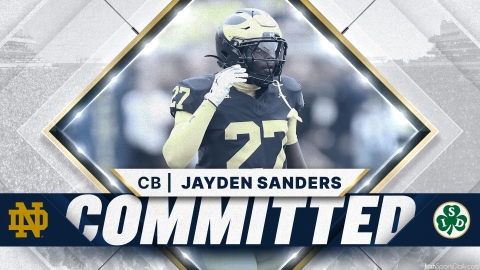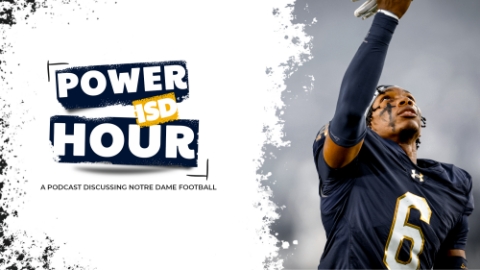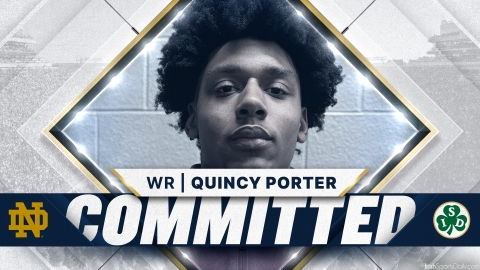
Notre Dame’s backfield has as much talent as they’ve had in many years. Strictly looking at the runners who will be getting carries, one would think that the Irish offense is poised to go from good to elite with better versions of Kyren Williams and Chris Tyree toting the rock.
Everyone knows that’s not likely going to be the case, though. How could it be when Notre Dame has to replace so many of the blockers who made them so successful in 2020?
18stripes’ Michael Bryan did a fantastic job breaking down Notre Dame’s running game last season. I highly recommend that you check out the full piece, but this graphic he shared on Twitter sums up how the ‘20 running game was very comparable to the 2017 season minus some explosive runs (which I’ll get to in a bit).
Williams, Tyree, and C’Bo Flemister were a huge part of the success running the ball, but it was the line and the work of the tight ends, Tommy Tremble in particular, that were the engine behind it all.
Four new starters up front means that a regression is pretty much inevitable. As MB highlighted in the chart, there was one in 2018 when Quenton Nelson and Mike McGlinchey moved on to the NFL. It was significant when it comes to Adjusted Line Yards where they were 5th in ‘17 and dropped all the way to 106th. With most of the line coming back in 2019, they went back up to 62nd. They were 26th last fall.
Talent matters on the O-line. The 2015 running game that featured three eventual top-10 picks and a future 2nd rounder finished 2nd in ALY. The 2016 running game was still 18th despite losing a couple of key starters.
The 2021 line could be very talented. It’s also going to be very inexperienced, which is why looking at potential options in the transfer portal who have some experience could help offset some potential issues.
Even with that, as MB pointed out in his piece, there’s a good chance Notre Dame will be far less efficient running the ball. The way to counter that isn’t just improvement over the course of the season by a line that should get better each month. It’s probably going to depend on the running game finding more explosive plays than they had last season.
One way to do that is get players like Braden Lenzy (18.8 yards per carry in ‘19), Lawrence Keys, and true freshman Lorenzo Styles more involved. That means that offensive coordinator Tommy Rees may have to dip back into some of what Chip Long did in terms of scheming up some of those explosive opportunities. Getting Tyree and Williams out on the perimeter more on passes behind the line of scrimmage is another way to potentially unlock more explosive plays.
It also might mean that, even if he’s not the regular quarterback, there may be a need to get Tyler Buchner involved as a runner to help replace some of what they’ll be missing without Ian Book. Book had 23 runs of 10 yards or more last season, the sixth most out of any FBS quarterback. Jack Coan has three in 2019.
One of the reasons that the ‘17 running game was more explosive didn’t just have to do with Brandon Wimbush’s running ability. It was the threat he posed as a runner and teams being forced to defend that and the threat of RPOs (eventually teams got wise and realized they didn’t have to worry about the passing threat).
I think we’ve already seen glimpses that the offense this season will look much different than it did last year. That’s because it will have to be. If it was the same, then it’s very likely we’d see a significant regression because the strengths of the personnel are going to be different.
It seems unavoidable that they will take a step back when it comes to run blocking. It’s going to be about how they can fill the void and if the offense can manage to improve knowing that it will have to be different to do so.
2. As I was going through returning production numbers in recent years, I found that a lot of bad teams stayed bad on one side of the ball even with a lot coming back the next season.
Boston College’s defense last year is a great example. They were 16th in returning production and with a new head coach who had just done a fantastic job with Ohio State’s defense, it seemed like they would be much improved.
They weren’t. They were better, but still bad. They jumped to 86th from 103rd in FEI.
The reality was that the guys who were coming back weren’t very good. The guys that Don Brown recruited and developed were gone. Talent matters and they didn’t have enough of it.
Georgia Tech was 2nd in returning production on defense heading into 2020. Again, they had a head coach in Geoff Collins who has had a track record of coaching great defenses. That didn’t matter as they only improved from 88th in FEI from 96th in 2019.
Pitt’s offense was 24th in returning production. They still had a bad O-line and not enough skill talent. They only improved to 99th from 108th.
There are some cases where the right combination of experience and talent can spark a team to go from bad to great on one side of the ball. Minnesota, 4th in returning production on offense in ‘19, jumped from 83rd to 8th. Indiana was 13th in returning production on defense in ‘20. They jumped from 77th to 5th.
That’s pretty rare for that to happen and it’s much more common for returning production to not matter as much with programs who were bad the previous year. That’s something worth remembering when considering Florida State’s offense.
They added McKenzie Milton as a transfer quarterback and are 25th in returning production, but the odds of them going from 95th in FEI to a top-20 group this season are very, very low.
3. I’m working on a piece on the returning production for each Notre Dame opponent this season and even though this isn’t a big part of the piece, I did look at 247Sports’ team talent rankings and where teams have been trending.
Notre Dame has been in the top-10 (10th, 10th, and 8th) in three of the last four seasons. They are likely to be a top-10 team in raw recruited talent on the roster again in 2021. While they have managed to stay pretty steady, some of the teams they’re competing with have not.
In 2017 Stanford was 14th. They dropped to 20th last year and are going to drop even further after signing a class that had only one 4-star recruit.
USC was all the way up at 3rd in 2017 and were 10th last season.
Florida State was 5th back in 2017 and they dropped all the way to 16th. With their last recruiting class, they aren’t moving back up any time soon.
Michigan was 7th in ‘17 and was 17th in 2020.
I know Notre Dame fans want to see the Irish jump back into the top-five in talent, but what’s happened with some of their rivals shows that even staying around the same means they are staying ahead of others.
4. Brian Kelly started out 2-6 in his first eight games against Stanford. His teams scored more than 20 points only once in those games (a 38-36 loss in 2015).
The last two games against the Cardinal the Irish put up 38 and 45. That’s because the Stanford defense, the backbone of their success in the Harbaugh/Shaw era, has taken a steep decline.
From 2010-2014, they ranked 10th, 25th, 8th, 13th, and 8th in FEI.
Since 2017 they’ve ranked 60th, 47th, 90th, and 112th (where the players dwell).
They are 81st in returning production on defense and with the way they’ve recruited as of late, they aren’t going to get a lot better than where they were last year.
The days of “manball” and stingy defense are gone at Stanford. If Notre Dame has the offense rolling by the end of the year, dropping 40 on them feels like a certainty.
5. Is Cincinnati a threat to beat Notre Dame this season? Of course they are. They’ll be one of the toughest matchups on the schedule, primarily because their defense will be one of the best the Irish face.
How good their offense can do against Marcus Freeman’s defense will likely determine if they can go on the road and win at Notre Dame. That’s something I am less sure about.
Part of that has to do with them replacing their two starting tackles. I don’t think that will be a great recipe against ND’s front. The other piece of it is quarterback Desmond Ridder. He was very good last season. However, they had the benefit of not playing many above average defenses.
Over the last two years he’s faced Georgia (12th in FEI), (Tulsa 9th), Ohio State (2nd in 2019), Central Florida (27th in 2019), and Temple (38th in 2019). His combined yards per attempt in those games was 5.99. He’s a dual-threat, but he didn’t exactly shine as a runner in those games either. The Tulsa game was the only one where he had over 200 yards of total offense and that’s not going to get it done if they are going to upset the Irish.
Against Georgia last season, against a defense that had three starters opt out of playing, he finished with 189 total yards and threw for 5.6 yards per attempt.
6. If you’re wondering why Notre Dame is interested in former Tulsa corner Akayleb Evans, look no further than his size (6’2”) and what he showed in man coverage. Though he was only in man to man on 37.1% of his coverage snaps last season, he managed to only give up a 33.3% completion percentage.
Even if Notre Dame is happy with Cam Hart, Ramon Henderson, TaRiq Bracy, and Clarence Lewis, it wouldn’t hurt to have a player like Evans with his size, experience, and ability to succeed in man to man. I think it’s very likely we’re going to see a lot more man coverage from Freeman’s defense as opposed to what we saw from Clark Lea.
Lewis was in man 22.4% of the time last season. McCloud was 25.7% of the time and Bracy 27.2%. Cincinnati’s top four corners were all above 43%.
I’m sure Freeman wants to play more man coverage than the defense did at ND last season. Adding someone like Evans would give him more flexibility to do so.



